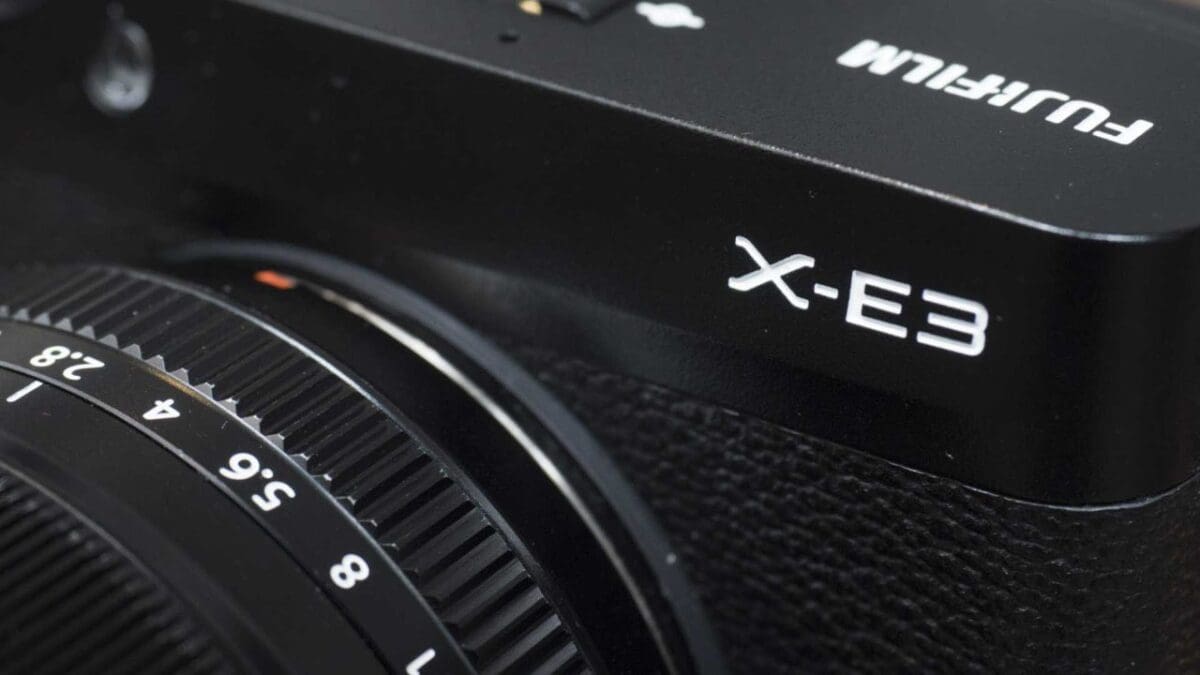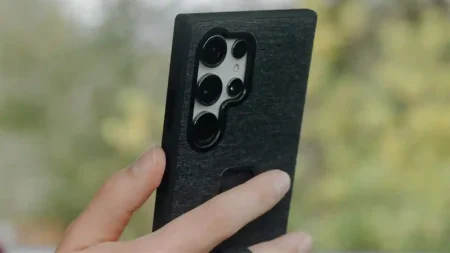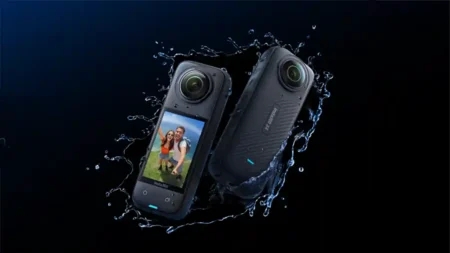The X-E3 completes Fujifilm’s cycle of updating its mirrorless system cameras to the 24.3Mp X-Trans CMOS III APS-C sensor and X-Processor Pro processing engine combination that appears in the X-T2, X-Pro2, X-T20, and X100F. As a result, it’s capable of producing high-quality images with plenty of detail and attractive colours that are dictated by the selected Film Simulation mode. It also has an ingenious touch-control system and a mini-joystick that takes the place of a traditional navigation pad and really improves the handling. It’s a gem of a camera.
For Fujifilm X-E3
- Excellent sensor and processor combination
- Superb Film Simulation modes
- Fast, accurate autofocus system
Against Fujifilm X-E3
- Fixed screen
- Unreliable Bluetooth/Wi-Fi system
- Main menu not operable via touch-control
What is the Fujifilm X-E3?
The Fuji X-E3 is an APS-C format compact system or mirrorless camera with the Fujifilm X lens mount. It’s the replacement for the 16Mp Fuji X-E2S which was announced in January 2016. Like the camera it replaces, it has a rectangular rangefinder-like design and an electronic viewfinder built-in.
Fujifilm X-E3 Specification
Perhaps the biggest, but also the most predictable upgrade that the X-E3 makes to the X-E2S is the change from a 16Mp sensor to a 24.3Mp device. It’s predictable because it’s the same 24.3Mp X-Trans CMOS III APS-C sensor as has appeared in the Fuji X-Pro2, X-T2 and X100F. Also, like these other cameras, the sensor is paired with the X-Processor Pro processing engine.
This combination enables a standard sensitivity range of ISO 200 to 12800 with extension options taking it to ISO 100 to 51200. It’s also possible to shoot up to 21 uncompressed raw files or 35 jpegs at 14fps (frames per second) using the electronic shutter. If you want to focus continuously, however, this drops to 11fps and 53 jpegs or 21 uncompressed raw files. Switch to the mechanical shutter drops the maximum rate to 8fps for 62 jpegs or 25 uncompressed raw files.
In another significant upgrade upon the X-E2S the 3-inch 1,040,000-dot screen on the X-E3 is a touchscreen. And in addition to the usual Touch Shot, Touch AF and Focus Area Selection options there’s a Touch Function feature that enables gesture control that’s familiar from smartphones.
Autofocus
Fujifilm has updated the phase detection autofocus algorithm to boost its performance with moving subjects. This is now claimed to take around half the time of the X-E2 to focus and subject can be half the size that it needs to be with the X-E2S.
According to Fujifilm, the X-E3 can also get subjects sharp in as little as 0.06sec.
There are up to 325 focus points (in a 13 x 25 grid) available for selection, but if you prefer this can be limited to 91 (in a 7 x 13 grid). These can be selected individually in single focus point mode or the camera select one automatically in Wide/Tracking AF mode. Alternatively, there’s Zone AF which is useful when you know roughly where the subject will be in the frame.
Like the X-T2 and X-T20, the X-E3 has a collection of five autofocus customisation options that tailor how the camera responds in continuous autofocus mode (AF-C). Unlike the X-T2 (but like the X-T20), it’s not possible to adjust the individual parameters such as Tracking Sensitivity that are controlled by these settings, but they are a useful addition to the feature set. The options are:
- Standard setting – a good all-rounder
- Ignoring obstacles – useful if pillars or posts are likely to come between you and the subject
- Accelerating / decelerating subjects – of subjects that change speed
- For subjects that suddenly come into the frame – to focus quickly or switch between subjects
- Erratically moving subjects – a good option for shooting birds and wildlife
Video specification
Fujifilm doesn’t offer a dedicated video camera like the Panasonic GH5 and Sony A7S II but it enables photographers to shoot video that compliments the stills by using the Film Simulation modes.
It’s possible to record 4K (3840 x 2160) at 29.97, 25p, 24p or 23.98p and 100Mbps for up to 10 mins at a time. Full HD (1920 x1080) movies can be recorded at up to 59.94p and 36Mbps for up to 15
Build quality and handling
Like the X-E2S, the X-E3 has a rectangular rangefinder-like shape with the viewfinder fitting within the rectangle rather than protruding above the top-plate like the mini-DSLR X-T20 and X-T2. It’s like a smaller version of the X-Pro2. Unlike the X-Pro2, however, there’s no optical element to the viewfinder, it’s purely electronic.
Although the grip on the front of the X-E3 body is quite shallow and there’s only a small thumb-ridge on the back, they are both covered with a grippy, textured finish that makes the camera feel comfortable and secure when you’re shooting one-handed. And while it feels okay with a lens like the XF 18-55mm F2.8-4 R LM OIS mounted, it looks and feels more natural and better balanced with a prime lens like the XF 23mm F2 R WR.
Control arrangement
Although the X-E3 will seem familiar to X-E2S users, there are some significant and welcome changes to the control arrangement. The most significant of these is that Fujifilm has done-away with the usual navigation pad on the back of the camera. Instead, there’s a mini-joystick control that Fuji calls a ‘focus lever’. This sits in line with the Menu, Display and Playback buttons and falls within convenient reach of your right thumb. It makes it easy to navigate through menu options, make settings selections and set the AF point. It’s much faster and easier to use than the navigation pad.
Further good news is that getting rid of the navigation pad means there’s more room on the back of the camera for your thumb so the X-E3 is easier and more comfortable to hold than the X-E2S.
Fujifilm has also given the X-E3 a front dial, which works in tandem with the rear dial for scrolling through menu options and browsing through settings.
While there’s a lens aperture ring and both shutter speed and exposure compensation dials on the X-E3’s top-plate there’s no sensitivity (ISO) dial. However, there’s an ‘ISO Command Dial Setting’ option in the Set-up menu that enables you to set ISO via the new front command dial. I found this useful for those occasions when I wasn’t using the camera in Auto ISO mode.
Touch-Control
As mentioned earlier, the X-E3’s screen is touch-sensitive and it’s possible to swipe up, down, left, and right to access key features such as AF mode, sensitivity (ISO), Film Simulation mode, and white balance. Initially, there may be mixed success with using this gesture control but discovering the need for quick swipes improves interaction. Once accustomed, it speeds-up making adjustments.
These gestures can also be used while the camera is held to your eye, and you can specify whether you want to use the whole screen or just the left or right area, offering convenience for right-eyed shooters. Customisation of the Touch Function is available via the Button/Dial setting option in the Set-up menu, with a total of 31 options plus ‘Off’.
Additionally, you can drag your thumb on the screen to select the AF point you want while looking in the viewfinder, though using the Focus Lever (joystick) might be easier for some.
Viewfinder and screen
The X-E3’s electronic viewfinder, while not the largest that Fuji offers, provides a clear view of the scene and matches the final image well. The screen quality is also commendable, suffering minimally from reflections. However, the fixed nature of the screen is a drawback, limiting viewing flexibility during high or low-angle shots. A tilting mechanism, similar to that on the X-T2, or a vari-angle hinge would enhance its functionality.
Performance
As it has an electronic viewfinder that can show the image as it will be captured, taking into account the exposure and colour settings, it’s rare that you’ll find an image that isn’t exposed as you’d like it to be. Nevertheless, I found that in its Multi setting the X-E3’s 256-Zone metering system copes well with some scenes that might fool other cameras. When photographing a river under an overcast sky, for example, it delivered an excellent image with no intervention on my part. In fact, there were remarkably few occasions when I needed to use the exposure compensation dial to prevent the subject from being under- or over-exposed.
If you should underexpose an image, either accidentally or to protect the highlights, you’ll find that the X-E3’s low ISO raw files have good dynamic range and can withstand quite substantial brightening.
Image Quality
As I mentioned earlier, the X-E3 has the same sensor and processing engine as the Fujfilm X-T2, X-Pro2. X-T20 and X100F. This means that it produces very similar images and noise is controlled well throughout the native sensitivity range (ISO 200—12,800). Naturally, some detail is lost at the uppermost settings, but the results are good and even the expansion settings can produce passable images.
As you’d expect, if you want the best images, the sensitivity should be kept to the lower values as that ensures the highest level of detail and best colour saturation. Ideally, keep to ISO 3,200 or lower but don’t stress too much if you need to go to ISO 6400 or even 12,800.
Fujifilm’s Film Simulation modes, combined with the Shadow and Highlight tone controls allow you to give jpegs the look you want. Everyone has their favourite, but some suit some scenes better than others. I particularly like Classic Chrome for it’s slightly muted colours and warm tones. I like to push the Shadow tone pup a little to deepen the shadows and boost contrast. Acros is also another favourite for black and white images.
As with other Fujifilm cameras, the X-E3’s automatic white balance setting is a good default option, but the Daylight setting delivers slightly more attractive results in some natural light situations (shade for example) – in others, it’s indistinguishable from the Auto WB result.
Autofocus
The Fuji X-T2 or X-T20 is perhaps the more natural choice for shooting sport and action as their shape works better with long lenses, but the X-E3’s autofocus system is fast and accurate so it is feasible to shoot fast-moving subjects with it if you want.
However, the X-E3 is more at home with small prime lenses than it is with long telephoto zoom optics, so it’s more likely to be used for landscape, documentary and street photography. But it’s good to have the potential if you need it – and fast focusing can be useful for street photography.
The X-E3’s AF system also proves reliable in quite low lighting and with the XF 23mm F2 R WR mounted, it achieved sharp focus even with some really low contrast subjects during my testing.
Wireless Transfer
I found the X-E3’s Bluetooth and Wi-Fi automatic image transfer system rather hit and miss. There were many instances when I saw the lights on the camera flashing as I turned it off, but when I checked my phone, the images weren’t there. The problem was usually solved by opening the Fujifilm Remote app on my phone and tapping the camera’s name to reform the connection. The app usually issued a warning about the need to open the phone settings and connect to the camera’s Wi-Fi system, but if I waited a few seconds it worked it out for itself.
From this point, I could then use my phone to browse the images on the card in the camera and select the ones I wanted to transfer – and they would copy across without a hitch. After that any images, I shot subsequently would also usually transfer automatically until the next time that the camera and phone were out of range and I’d have to make the connection again.
It’s clear that there’s a little work to be done before we can expect automatic image transfer to be seamless.
Sample Images



Follow this link to view and download full-resolution X-E3 files
Verdict
When first introduced to the X-E3, one might think it’s a scaled-down version of the X-Pro2, aimed at those who can’t stretch their budget to the higher-end model. However, Fujifilm has endowed the X-E3 with distinct features that make it a compelling choice in its own right.
Notably smaller and lighter, the X-E3 introduces a more streamlined way of operating, reducing reliance on physical buttons that can sometimes slow down the shooting process. The Touch Function facilitates quick access to four essential features, enhancing operational speed, provided one remembers the swipe directions. Additionally, the replacement of the traditional navigation pad with a joystick, or ‘focus lever’ as Fuji terms it, not only saves space but also simplifies handling, particularly when using the viewfinder.
While the X-E3’s design seems optimized for prime lenses, its capable autofocus system ensures it performs admirably with longer lenses too, making it versatile for shooting various subjects, including sports. The camera’s image output, characterized by Fujifilm’s signature color rendition and pleasing mid-tone contrast, further solidifies its appeal.
The primary shortcomings are its fixed screen and the need for improvement in its Bluetooth/Wi-Fi connectivity. These issues aside, the X-E3 stands out for its ergonomic design and excellent image quality.
Fujifilm X-E3 Rating
- Overall Score: 4.5/5
- Features: 4.5/5
- Build and Handling: 4/5
- Performance: 4.5/5
- Image Quality: 4.5/5
Should I buy a Fujifilm X-E3?
If you appreciate cameras with traditional exposure controls, prefer a compact and unobtrusive design, and prioritize high-quality image output, the Fujifilm X-E3 is an excellent choice. It’s a camera that’s likely to win you over with time and usage, proving its value beyond its initial appeal.



